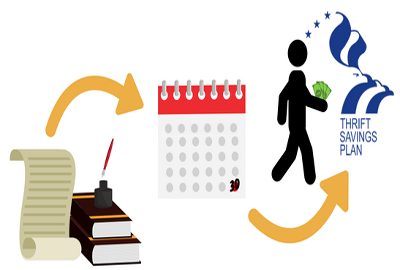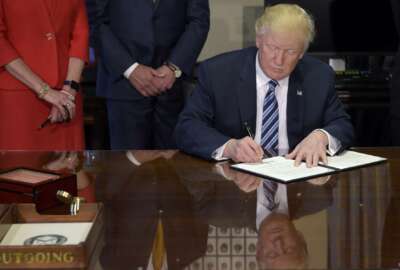
5 questions about TSP’s new withdrawal options, answered
The agency that administers the Thrift Savings Plan is planning to implement new withdrawal options for its participants by next September. Here's what participants...
Participants in the Thrift Savings Plan have been asking for them for years. Today, the agency that administers the TSP is about one year away from giving its participants more options when withdrawing their investments from their accounts.
As part of its annual World Investor Week, the Securities and Exchange Commission partnered with the TSP on Tuesday to answer questions from federal employees who may retire or leave federal service in the near future.
Experts from the TSP and the SEC took a variety of questions from federal employees but spent the bulk of the two-hour training event covering the upcoming changes to the plan’s withdrawal options.
The SEC said it had more than 5,000 people watching the live webinar, in addition to the 100 or so people in its auditorium in person on Tuesday afternoon. The agency is planning to archive the seminar, which is expected to post on its website by Friday.
In the meantime, here are five things you should know about the new TSP withdrawal options.
When will the new TSP withdrawal options be available?
The Federal Retirement Thrift Investment Board (FRTIB), the agency that administers the TSP, expects the new options will be available by September 2019.
The TSP Modernization Act, which President Donald Trump signed into law last November, gives the FRTIB up to two years to implement the new changes.
The FRTIB has been writing regulations and preparing new forms to reflect the array of new options, since last September, before the TSP Modernization Act became law.
So what are the new withdrawal options?
Under the new system, all TSP participants will be able to take one withdrawal every 30 days.
Participants who are still in federal service at age 59½ or older will be able to take up to four partial withdrawals from the TSP during a given calendar year. The 30-day limit still applies, however, so participants can’t take four partial withdrawals during the span of two months, for example.
Those who have left federal service will have no other limitations beyond the 30-day requirement to make partial withdrawals from the TSP.
Currently, in-service TSP participants can make only one partial withdrawal at age 59½ or older. Other participants who have left government can only make one partial post-separation withdrawal — either a lump-sum payment, a series of monthly payments or annuity payment — under current law by age 70½.
Under the new options, TSP participants who have left federal service can take monthly, quarterly or annual installment payments as part of a post-separation withdrawal. Applicable participants can make changes to these payments, which they can stop and restart at any time, at any point during the year. Currently, participants can only make changes to their installment payments during open season, which typically runs from early October to mid-December.
Participants can also request partial withdrawals while receiving installment payments.
Currently, participants who have left federal service must make a full withdrawal by age 70½, where they’ll either set up monthly installments, an annuity or a lump sum. If they don’t decide how and when they’ll fully withdraw from the TSP, the FRTIB “abandons” the account.
Moving forward, the FRTIB plans to eliminate the deadline to make a full withdrawal election. Instead, the agency will pay the remaining difference of a participant’s TSP account through required minimum distributions (RMDs) to those who have reached age 70½ and haven’t determined how they’d like to withdraw the remaining funds in their accounts.
In the future, these participants will receive notices from the TSP reminding them that they haven’t made a full withdrawal election. These participants would receive several reminders throughout the year to take the required minimum distributions (RMDs), which the Internal Revenue Code determines every year.
Will I have more options to determine where my payments come from?
Yes.
Currently, participants receive withdrawal payments proportionally from their traditional and Roth balances.
In the future, participants will be able to draw from either their traditional or Roth balances. They can also continue to tap into the “pro-rata” traditional/Roth mix.
Can I use new TSP withdrawal options if I’m planning retire before September 2019?
Yes.
Even though the FRTIB is preparing a slate of new withdrawals for September 2019, it’s not getting rid of any of the options TSP participants currently have, said Randy Urban, a TSP supervisory training and liaison specialist with the agency.
TSP participants won’t be “grandfathered in” to the existing withdrawal structure, he added. Anyone who retires before the new options become available can make a change to their post-separation payment structure or amount, Urban said.
Will the TSP withdrawal forms change?
The TSP will have some new withdrawal forms. Others will be tweaked slightly to reflect changes to the new system, Urban said.
Regardless, separated participants shouldn’t submit a withdrawal form until they’ve officially left federal service, the TSP said.
Married participants should find and print their withdrawal forms from the TSP website. In most situations, the TSP will require these participants to provide notarized signatures from their partners on the form itself.
Separated participants who want to make a change to their monthly payments, again, will need to include a signature from a spouse, Urban said.
Copyright © 2025 Federal News Network. All rights reserved. This website is not intended for users located within the European Economic Area.
Nicole Ogrysko is a reporter for Federal News Network focusing on the federal workforce and federal pay and benefits.
Follow @nogryskoWFED





